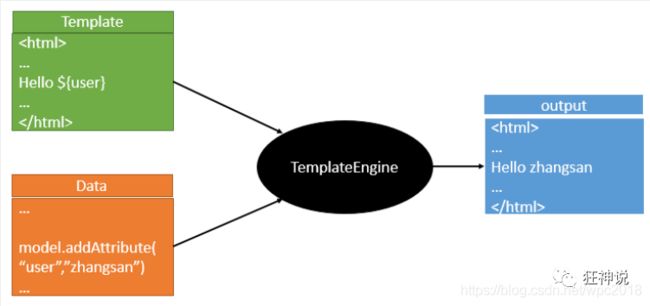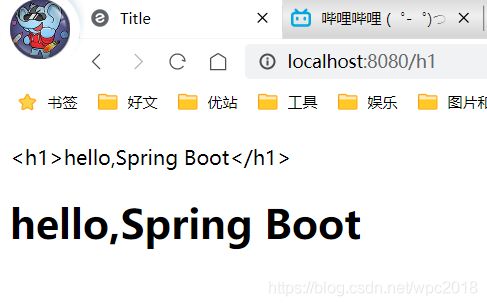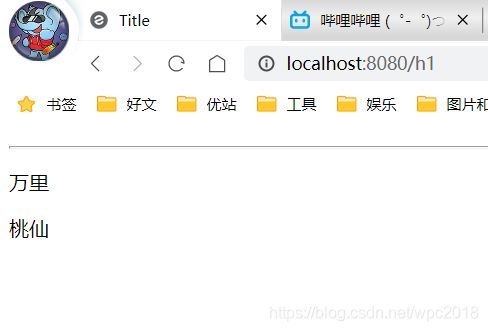Spring Boot——整合 Thymeleaf模板引擎
文章目录
- Spring Boot——Thymeleaf模板引擎
-
- 1、什么是Thymeleaf
- 2、什么是模板引擎
- 3、Thymeleaf的简单测试
- 4、Thymeleaf语法使用
-
- 4.1、命名空间
- 4.2、简单表达式
Spring Boot——Thymeleaf模板引擎
1、什么是Thymeleaf
Thymeleaf是一个XML/XHTML/HTML5模板引擎,可用于Web与非Web环境中的应用开发,可以作为mvc的web应用的view层。它是一个开源的Java库,基于Apache License 2.0许可,由Daniel Fernández创建,该作者还是Java加密库Jasypt的作者。
Thymeleaf提供了一个用于整合Spring MVC的可选模块,在应用开发中,你可以使用Thymeleaf来完全代替JSP,或其他模板引擎,如Velocity、FreeMarker等。Thymeleaf的主要目标在于提供一种可被浏览器正确显示的、格式良好的模板创建方式,因此也可以用作静态建模。你可以使用它创建经过验证的XML与HTML模板。相对于编写逻辑或代码,开发者只需将标签属性添加到模板中即可。接下来,这些标签属性就会在DOM(文档对象模型)上执行预先制定好的逻辑。

2、什么是模板引擎
模板引擎(这里特指用于Web开发的模板引擎)是为了使用户界面与业务数据(内容)分离而产生的,它可以生成特定格式的文档,用于网站的模板引擎就会生成一个标准的HTML文档。
Thymeleaf 是一个服务器端 Java 模板引擎,能够处理 HTML、XML、CSS、JAVASCRIPT 等模板文件。Thymeleaf 模板可以直接当作静态原型来使用,它主要目标是为开发者的开发工作流程带来优雅的自然模板,也是 Java 服务器端 HTML5 开发的理想选择。
从字面上理解模板引擎,最重要的就是模板二字,这个意思就是做好一个模板后套入对应位置的数据,最终以html的格式展示出来,这就是模板引擎的作用。
模板引擎就是我们用来写一个页面模板,比如有些值呢,是动态的,我们写一些表达式可以取出来。而这些值,从哪来呢,就是我们在后台封装一些数据。然后把这个模板和这个数据交给我们模板引擎,模板引擎按照我们这个数据帮你把这表达式解析、填充到我们指定的位置,然后把这个数据最终生成一个我们想要的内容给我们写出去,这就是我们这个模板引擎,不管是jsp还是其他模板引擎,都是这个思想。
3、Thymeleaf的简单测试
Thymeleaf官网
Thymeleaf 在GitHub主页
springboot文档
步骤:
1、引入Thymeleaf依赖
<dependency>
<groupId>org.thymeleafgroupId>
<artifactId>thymeleaf-spring5artifactId>
dependency>
<dependency>
<groupId>org.thymeleaf.extrasgroupId>
<artifactId>thymeleaf-extras-java8timeartifactId>
dependency>
查看下载好的jar包,我们开发的时候要使用3.0.x版本的
2、编写控制器和页面
@Controller
public class HelloController {
@RequestMapping("/h1")
public String hello(){
return "test";
}
}
页面放在templates目录下,注意:templates目录下的页面只能通过controller访问
DOCTYPE html>
<html lang="en">
<head>
<meta charset="UTF-8">
<title>Titletitle>
head>
<body>
hello
body>
html>
启动springboot应用程序测试。成功跳转!这个测试只是简单是实现页面跳转,没有规范的使用Thymeleaf。
4、Thymeleaf语法使用
4.1、命名空间
通过引入 Thymeleaf 命名空间。
4.2、简单表达式
| 语法 | 名称 | 描述 | 作用 |
|---|---|---|---|
| ${…} | Variable Expressions | 变量表达式 | 取出上下文变量的值 |
| *{…} | Selection Variable Expressions | 选择变量表达式 | 取出选择的对象的属性值 |
| #{…} | Message Expressions | 消息表达式 | 使文字消息国际化,I18N |
| @{…} | Link URL Expressions | 链接表达式 | 用于表示各种超链接地址 |
| ~{…} | Fragment Expressions | 片段表达式 | 引用一段公共的代码片段 |
${…}测试:
@RequestMapping("/h1")
public String hello(Model model){
model.addAttribute("msg","hello,Spring Boot
");
return "test";
}
DOCTYPE html>
<html lang="en" xmlns:th="http://www.thymeleaf.org">
<head>
<meta charset="UTF-8">
<title>Titletitle>
head>
<body>
<h1>
<p th:text="${msg}">p>
<p th:utext="${msg}">p>
h1>
body>
html>
启动springboot应用程序测试,上面的把h1标签转义了,下面的没有
测试th:each
@RequestMapping("/h1")
public String hello(Model model) {
model.addAttribute("users", Arrays.asList("万里","桃仙"));
return "test";
}
DOCTYPE html>
<html lang="en" xmlns:th="http://www.thymeleaf.org">
<head>
<meta charset="UTF-8">
<title>Titletitle>
head>
<body>
<p th:each="user:${users}" th:text="${user}">p>
<span th:each="user:${users}">[[${user}]]span>
h1>
body>
html>
启动springboot应用程序测试,成功把值遍历出来!
Thymeleaf的表达式语法:
Simple expressions:(表达式语法)
Variable Expressions: ${...}:获取变量值;OGNL;
1)、获取对象的属性、调用方法
2)、使用内置的基本对象:#18
#ctx : the context object.
#vars: the context variables.
#locale : the context locale.
#request : (only in Web Contexts) the HttpServletRequest object.
#response : (only in Web Contexts) the HttpServletResponse object.
#session : (only in Web Contexts) the HttpSession object.
#servletContext : (only in Web Contexts) the ServletContext object.
3)、内置的一些工具对象:
#execInfo : information about the template being processed.
#uris : methods for escaping parts of URLs/URIs
#conversions : methods for executing the configured conversion service (if any).
#dates : methods for java.util.Date objects: formatting, component extraction, etc.
#calendars : analogous to #dates , but for java.util.Calendar objects.
#numbers : methods for formatting numeric objects.
#strings : methods for String objects: contains, startsWith, prepending/appending, etc.
#objects : methods for objects in general.
#bools : methods for boolean evaluation.
#arrays : methods for arrays.
#lists : methods for lists.
#sets : methods for sets.
#maps : methods for maps.
#aggregates : methods for creating aggregates on arrays or collections.
==================================================================================
Selection Variable Expressions: *{...}:选择表达式:和${}在功能上是一样;
Message Expressions: #{...}:获取国际化内容
Link URL Expressions: @{...}:定义URL;
Fragment Expressions: ~{...}:片段引用表达式
Literals(字面量)
Text literals: 'one text' , 'Another one!' ,…
Number literals: 0 , 34 , 3.0 , 12.3 ,…
Boolean literals: true , false
Null literal: null
Literal tokens: one , sometext , main ,…
Text operations:(文本操作)
String concatenation: +
Literal substitutions: |The name is ${name}|
Arithmetic operations:(数学运算)
Binary operators: + , - , * , / , %
Minus sign (unary operator): -
Boolean operations:(布尔运算)
Binary operators: and , or
Boolean negation (unary operator): ! , not
Comparisons and equality:(比较运算)
Comparators: > , < , >= , <= ( gt , lt , ge , le )
Equality operators: == , != ( eq , ne )
Conditional operators:条件运算(三元运算符)
If-then: (if) ? (then)
If-then-else: (if) ? (then) : (else)
Default: (value) ?: (defaultvalue)
Special tokens:
No-Operation: _
我们在学习过程中,需要使用什么,根据官方文档来查询,才是最重要的,要熟练使用官方文档:
Thymeleaf文本文档
Thymeleaf中文文本文档



